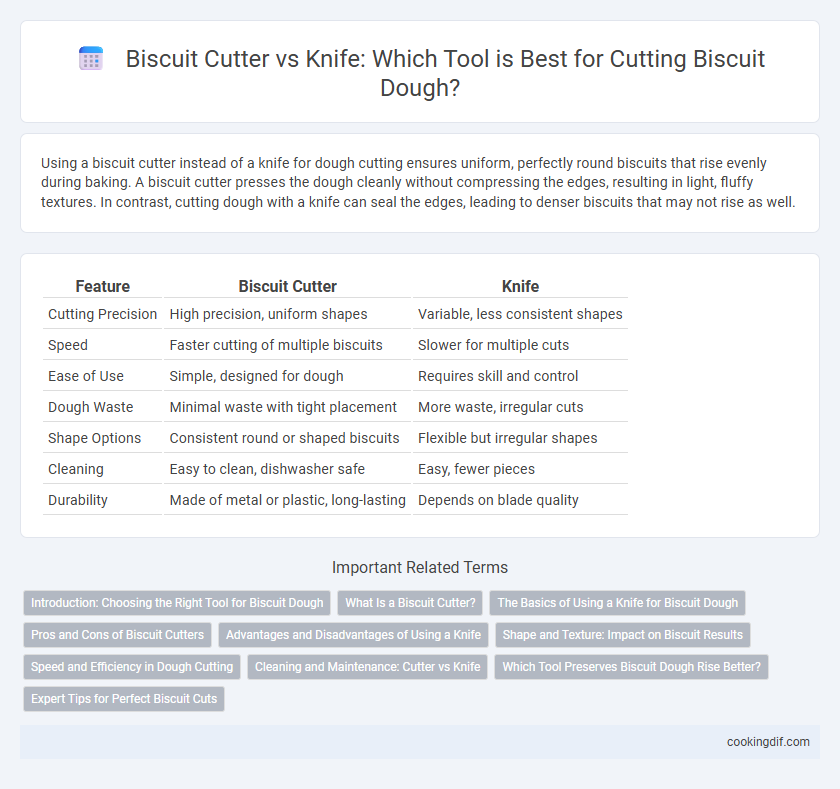Using a biscuit cutter instead of a knife for dough cutting ensures uniform, perfectly round biscuits that rise evenly during baking. A biscuit cutter presses the dough cleanly without compressing the edges, resulting in light, fluffy textures. In contrast, cutting dough with a knife can seal the edges, leading to denser biscuits that may not rise as well.
Table of Comparison
| Feature | Biscuit Cutter | Knife |
|---|---|---|
| Cutting Precision | High precision, uniform shapes | Variable, less consistent shapes |
| Speed | Faster cutting of multiple biscuits | Slower for multiple cuts |
| Ease of Use | Simple, designed for dough | Requires skill and control |
| Dough Waste | Minimal waste with tight placement | More waste, irregular cuts |
| Shape Options | Consistent round or shaped biscuits | Flexible but irregular shapes |
| Cleaning | Easy to clean, dishwasher safe | Easy, fewer pieces |
| Durability | Made of metal or plastic, long-lasting | Depends on blade quality |
Introduction: Choosing the Right Tool for Biscuit Dough
Selecting between a biscuit cutter and a knife for cutting dough significantly impacts the texture and rise of homemade biscuits. Biscuit cutters create clean, round edges that help biscuits maintain their shape and achieve a uniform rise due to minimal dough compression. Using a knife can cause uneven edges and compress the dough, potentially resulting in denser, less flaky biscuits.
What Is a Biscuit Cutter?
A biscuit cutter is a specialized kitchen tool designed to cut dough into uniform, circular shapes with clean edges, ensuring even baking and consistent biscuit texture. Unlike a knife, which can stretch or tear the dough, a biscuit cutter uses a sharp, round edge to create precise cuts that help maintain dough layers for optimal rise. Biscuit cutters are typically made from metal or plastic, featuring a handle or grip for easy pressing and retrieval from the dough surface.
The Basics of Using a Knife for Biscuit Dough
Using a knife for biscuit dough cutting provides straightforward control and flexibility in shaping, allowing bakers to quickly portion dough with minimal equipment. Unlike biscuit cutters, knives can create custom-sized biscuits, which helps when dough quantity or desired biscuit thickness varies. Proper technique involves a sharp knife and a clean, straight motion to avoid compressing the dough, preserving its light, flaky texture.
Pros and Cons of Biscuit Cutters
Biscuit cutters create uniform, clean edges that promote even rising and a professional appearance, essential for consistent baking results. They minimize dough wastage by cutting closely together, preserving dough integrity compared to knives which can tear or stretch the dough. However, biscuit cutters require cleaning and storage space, and their fixed shapes limit flexibility for creative or irregular designs that knives easily accommodate.
Advantages and Disadvantages of Using a Knife
Using a knife for cutting biscuit dough offers precision and flexibility in shaping biscuits but can result in uneven edges that affect rising quality. Knives allow quick portioning of dough without the need for specialized tools, making them convenient for irregular shapes or sizes. However, knife-cut biscuits may lack the clean, defined edges produced by biscuit cutters, potentially leading to denser, less uniform baking outcomes.
Shape and Texture: Impact on Biscuit Results
Biscuit cutters produce uniform, round shapes that promote even baking and consistent texture, preventing edges from becoming tough or overcooked. Knives tend to create irregular shapes and jagged edges, which can cause uneven rising and denser texture in some areas. Using a biscuit cutter also minimizes dough compression, helping maintain a flaky and tender crumb structure essential for high-quality biscuits.
Speed and Efficiency in Dough Cutting
Biscuit cutters provide faster and more efficient dough cutting compared to knives by ensuring uniform shapes with minimal effort, reducing prep time significantly. The sharp, circular design of biscuit cutters minimizes dough distortion and waste, enhancing productivity in high-volume baking. Knives often result in uneven cuts and slower processing, making biscuit cutters the preferred tool for consistent, rapid cutting.
Cleaning and Maintenance: Cutter vs Knife
Biscuit cutters are typically easier to clean and maintain due to their simple shape and fewer crevices where dough can get stuck, allowing for quick rinsing and drying. Knives require more careful cleaning to remove dough residue from the blade and handle, often needing thorough scrubbing and drying to prevent rust and maintain sharpness. Proper maintenance of biscuit cutters generally involves occasional oiling of the edges, while knives demand regular sharpening and careful storage to ensure longevity and optimal cutting performance.
Which Tool Preserves Biscuit Dough Rise Better?
A biscuit cutter preserves dough rise better than a knife because it creates clean, straight edges without compressing the dough, allowing the layers to remain intact for optimal fluffiness. In contrast, cutting with a knife often squashes the dough, which can hinder the biscuit's ability to rise properly. Professional bakers recommend using a biscuit cutter to achieve the best texture and height in homemade biscuits.
Expert Tips for Perfect Biscuit Cuts
Using a biscuit cutter ensures uniform thickness and clean edges, which promotes even baking and rise in biscuits. Expert bakers recommend chilling dough before cutting to prevent sticking and using a sharp, sturdy cutter to minimize dough compression. While knives can be used for shaping, they often create uneven edges and thickness, leading to inconsistent texture and baking results.
Biscuit cutter vs knife for dough cutting Infographic

 cookingdif.com
cookingdif.com